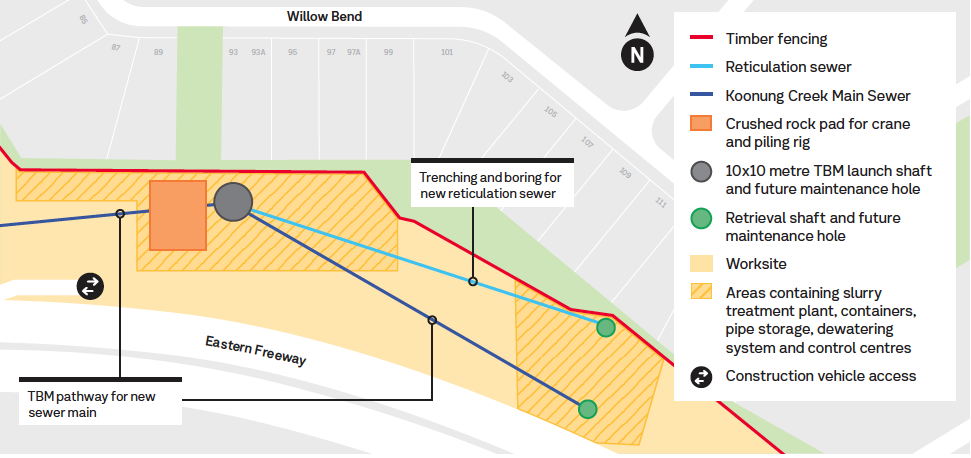14 November 2024

Relocating the Koonong Creek Main Sewer
To make room for new lanes on the Eastern Freeway, sections of Melbourne's sewer network, including the Koonung Creek Main Sewer, need to be relocated. This sewer, which runs alongside and across the freeway, services thousands of homes and businesses in Melbourne’s east.
We'll build around 1km of new sewer north of the freeway, between Bulleen and Doncaster roads, and install new reticulation sewers which are smaller pipes that will connect nearby homes to the new Koonung Creek Sewer main.
From late 2024 we'll be working in the reserve behind Willow Bend to relocate this essential infrastructure. The works will include, bored piling and excavation to build tunnel shafts and future maintenance holes, and using a mini tunnel boring machine (TBM) to dig a new sewer main.
Works behind Willow Bend
We’ll start by building a temporary launch shaft for the mini TBM. This involves digging a 10x10 metre hole. We’ll use a piling rig to dig deep holes around the perimeter, which will be filled with concrete and reinforcements to create the vertical walls of the shaft. The piles are interlocked to ensure the shaft is secure, an excavator will then remove the material from inside the shaft.
The mini TBM, about 1.5 metres in diameter, will begin tunnelling near Estelle Street. It will be retrieved at the launch shaft and then relaunched to tunnel 148 metres east to another retrieval shaft, building the new section of the main sewer.
We'll also relocate the existing reticulation sewer using both tunnelling and trenching methods to keep it connected to the main network.
What to expect
We'll be working behind Willow Bend from November 2024 until late 2026. You’ll notice workers and construction vehicles in the area.
We’ll build an access road directly from the freeway into our worksite to keep construction vehicles off local streets.
During sewer works, machinery including an excavator, a piling rig, a TBM and a crane are anticipated to generate increased levels of noise, dust and vibration at times near the worksite.
We’ll also have equipment on site such as a slurry treatment plant to temporarily store and treat slurry from tunnelling boring activities, a dewatering system to manage ground and surface water during construction, and a control centre and generator to operate the TBM. This equipment will also generate increased levels of noise when they're operating.
Excavated material will be temporarily stockpiled on site before being transported to an approved disposal facility in sealed tip trucks via the freeway.
How we'll manage impacts
As with all construction projects, there will be some noise, dust and vibration impacts to the community. These impacts will be closely managed and must comply with the project's strict Environmental Performance Requirements (EPRs).
We'll work closely with impacted residents to provide additional information on works, timing and how we propose to manage the expected disruptions.
Odour monitoring will be conducted on a weekly basis to identify and manage any potential odour travelling offsite. We’ll manage impacts by sealing areas with insulating foam to prevent odour escaping from the source, and utilising odour suppressants if required.
Keeping you up to date
There are many ways you can keep in touch and learn more about works in your area.
Speak to our team: Visit us at our Project Information Centre, 284 Doncaster Road, Balwyn North.
Contact us: You can also contact us on 1800 105 105 to speak to a member of the project team or to make an appointment to see us.
Sign up for updates: If you would like to receive SMS or email updates, visit: